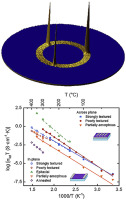当前位置:
X-MOL 学术
›
Acta Mater.
›
论文详情
Our official English website, www.x-mol.net, welcomes your feedback! (Note: you will need to create a separate account there.)
Comparison of the in- and across-plane ionic conductivity of highly oriented neodymium doped ceria thin films
Acta Materialia ( IF 9.4 ) Pub Date : 2018-04-01 , DOI: 10.1016/j.actamat.2017.12.057 George Baure , Hanhan Zhou , Ching-Chang Chung , Marissa N. Buck , Mariia A. Stozhkova , Jacob L. Jones , Juan C. Nino
Acta Materialia ( IF 9.4 ) Pub Date : 2018-04-01 , DOI: 10.1016/j.actamat.2017.12.057 George Baure , Hanhan Zhou , Ching-Chang Chung , Marissa N. Buck , Mariia A. Stozhkova , Jacob L. Jones , Juan C. Nino

|
Abstract To determine the effect of grain boundaries and grain orientation on the electrical properties of solid oxide fuel cell electrolytes, a comparison of the in-plane and across-plane ionic conductivity of both strongly and poorly textured, columnar-grained doped ceria thin films was performed within equivalent temperature ranges (150–300 °C). Additionally, the in-plane conductivity of partially amorphous films, polycrystalline films with randomly oriented grains, and single crystal, epitaxial films with no grain boundaries was determined. Pulsed laser deposition permitted the growth of all these types of films and the ability to grow columnar-grained doped ceria on both conducting and insulating surfaces enabled testing of the films both in-plane and across-plane. Compared to the columnar-grained samples, partially amorphous films exhibited a lower conductivity, while epitaxial doped ceria exhibited an enhancement in conductivity of 2 orders of magnitude. Between 300 and 400 °C, the in-plane conductivity of the strongly textured film was higher than the poorly textured one. The conductivity and activation energy in-plane and across-plane for the strongly textured film was similar (2.75 × 10−5 S/cm, 0.70 eV vs. 5.50 × 10−5 S/cm, 0.68 eV at 250 °C). In contrast, for the poorly textured films, the in-plane and across-plane conductivity values differed by almost an order of magnitude (2.86 × 10−5 S/cm, 0.55 eV vs. 1.99 × 10−4 S/cm, 0.78 eV at 250 °C) suggesting that the boundaries between oriented grains were less resistive. These results further strengthen the argument that grain orientation affects ionic transport through grain boundaries.
中文翻译:

高度取向的掺钕氧化铈薄膜的平面内和平面内离子电导率的比较
摘要 为了确定晶界和晶粒取向对固体氧化物燃料电池电解质电性能的影响,对强织构和差织构的柱状晶掺杂氧化铈薄膜的面内和跨面离子电导率进行了比较。在等效温度范围 (150–300 °C) 内进行。此外,还测定了部分非晶薄膜、具有随机取向晶粒的多晶薄膜和没有晶界的单晶外延薄膜的面内电导率。脉冲激光沉积允许所有这些类型的薄膜生长,并且能够在导电和绝缘表面上生长柱状晶粒掺杂氧化铈,从而能够对薄膜进行面内和面内测试。与柱状晶样品相比,部分非晶薄膜表现出较低的导电性,而外延掺杂的氧化铈表现出2个数量级的导电性增强。在 300 到 400 °C 之间,强织构薄膜的面内电导率高于织构差的薄膜。强纹理薄膜的平面内和平面内的电导率和活化能相似(2.75 × 10-5 S/cm,0.70 eV vs. 5.50 × 10-5 S/cm,250 °C 时为 0.68 eV)。相比之下,对于质地较差的薄膜,面内和跨面电导率值相差几乎一个数量级(2.86 × 10−5 S/cm,0.55 eV vs. 1.99 × 10−4 S/cm,0.78 eV at 250 °C)表明取向晶粒之间的边界电阻较小。这些结果进一步加强了晶粒取向影响离子通过晶界传输的论点。
更新日期:2018-04-01
中文翻译:

高度取向的掺钕氧化铈薄膜的平面内和平面内离子电导率的比较
摘要 为了确定晶界和晶粒取向对固体氧化物燃料电池电解质电性能的影响,对强织构和差织构的柱状晶掺杂氧化铈薄膜的面内和跨面离子电导率进行了比较。在等效温度范围 (150–300 °C) 内进行。此外,还测定了部分非晶薄膜、具有随机取向晶粒的多晶薄膜和没有晶界的单晶外延薄膜的面内电导率。脉冲激光沉积允许所有这些类型的薄膜生长,并且能够在导电和绝缘表面上生长柱状晶粒掺杂氧化铈,从而能够对薄膜进行面内和面内测试。与柱状晶样品相比,部分非晶薄膜表现出较低的导电性,而外延掺杂的氧化铈表现出2个数量级的导电性增强。在 300 到 400 °C 之间,强织构薄膜的面内电导率高于织构差的薄膜。强纹理薄膜的平面内和平面内的电导率和活化能相似(2.75 × 10-5 S/cm,0.70 eV vs. 5.50 × 10-5 S/cm,250 °C 时为 0.68 eV)。相比之下,对于质地较差的薄膜,面内和跨面电导率值相差几乎一个数量级(2.86 × 10−5 S/cm,0.55 eV vs. 1.99 × 10−4 S/cm,0.78 eV at 250 °C)表明取向晶粒之间的边界电阻较小。这些结果进一步加强了晶粒取向影响离子通过晶界传输的论点。



























 京公网安备 11010802027423号
京公网安备 11010802027423号